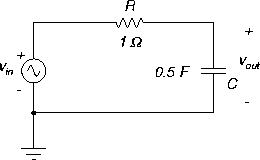



[ENGN2211 Home]
Load the PSPICE file
rc-tac.sch,
Figure 25.
Figure 21:
RC circuit.
 |
Exercise:
- 1.
- Simulate the circuit and first obtain the transient response.
Note carefully the transient and AC steady state portions
of the waveform. How long (approximately) does the transient period last?
- 2.
- Now enable AC sweep, disable transient, and simulate again.
Note the AC response.
The AC sweep has been set to decade type, with a start
frequency range of 0.0001 Hz up to 1.0 kHz.
The graph will be a plot of capacitor voltage versus frequency.
It can be used to determine the AC response (magnitude) at any frequency
on the x-axis (for phase, see below).
What is the magnitude of the capacitor voltage at 5 Hz?
- 3.
- The graph just produced will be linear-log. Let's now draw
a magnitude Bode diagram, which is dB-log.
- (a)
- Clear the PROBE display by Trace
 Delete All.
Delete All.
- (b)
- Now bring up the menu of available waveforms
Trace
 Add.
Add.
- (c)
- In the right side of the window that appears, click
on DB() for dB. It will appear in the bottom
Trace Expression portion of the window.
- (d)
- In the left portion of the window, click on
V(VC) for the capacitor voltage. It will appear in the bottom
Trace Expression portion of the window.
- (e)
- Click OK. The magnitude Bode diagram showing capacitor
voltage should now appear.
- 4.
- Determine from the graph the 3 dB point. Compare with theory.
Lecture Notes: Frequency Response : Bode Diagram
- 5.
- Now let's plot the phase response.
- (a)
- For illustration, let's add another plot to the
probe display Plot
 Add Plot. A new space
for plotting should appear above the magnitude Bode diagram.
Ensure that the new graph is selected.
Add Plot. A new space
for plotting should appear above the magnitude Bode diagram.
Ensure that the new graph is selected.
- (b)
- Bring up the menu of available waveforms
Trace
 Add.
Add.
- (c)
- In the right side of the window that appears, click
on P() for phase. It will appear in the bottom
Trace Expression portion of the window.
- (d)
- In the left portion of the window, click on
V(VC) for the capacitor voltage. It will appear in the bottom
Trace Expression portion of the window.
- (e)
- Click OK. The phase Bode diagram showing capacitor
voltage should now appear.
- 6.
- Determine the magnitude (dB) and phase at 0 Hz, 1 Hz, and at the 3 dB point.




[ENGN2211 Home]
ANU Engineering - ENGN2211
